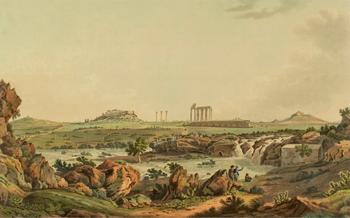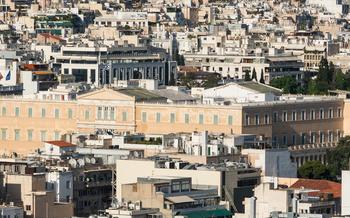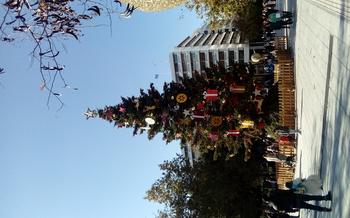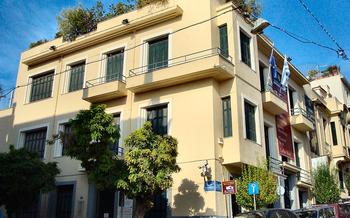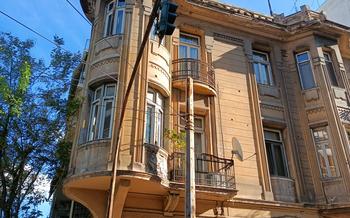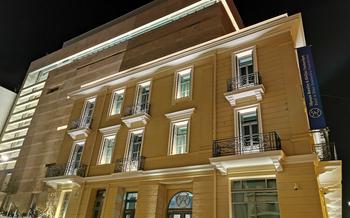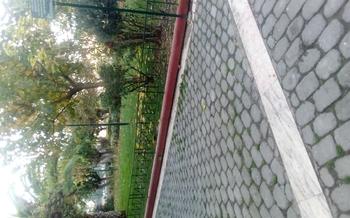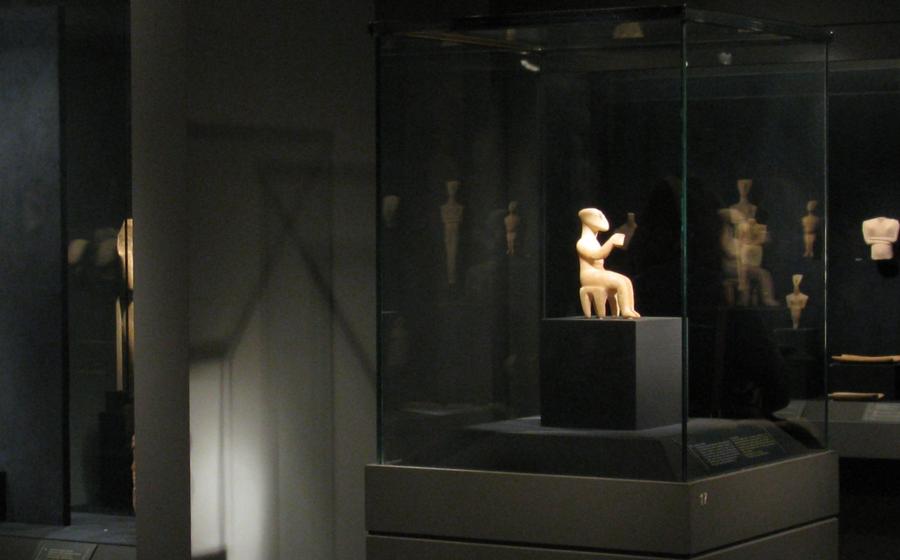
Museum of Cycladic Art
- Historical Background
- Location
- Collections
- Exhibition Highlights
- Museum Building
- Educational Programs
- Accessibility
- Visitor Information
- Museum Shop
- Photography Policy
- Food and Beverage
- Family-Friendly Activities
- Nearby Attractions
- Special Events
- Insider Tip: Unveiling Hidden Gems
Historical Background
The Cycladic civilization, named after the Cyclades island group in the Aegean Sea, flourished from approximately 3000 to 2000 BC. This remarkable culture produced a unique style of art characterized by distinctive marble sculptures, intricate pottery, and sophisticated metalwork. Cycladic art often depicted stylized human figures with smooth, simplified forms and a serene, introspective quality. The Cycladic era marked a pivotal period in Greek art and culture, laying the foundation for the development of classical Greek art and aesthetics.
Archaeological excavations conducted throughout the Cyclades in the late 19th and early 20th centuries uncovered a wealth of Cycladic artifacts, including the famous Cycladic figurines. These iconic sculptures, crafted from pure white marble, have become synonymous with Cycladic art and continue to captivate viewers with their enigmatic beauty and minimalist elegance. The discovery of these artifacts led to a growing appreciation for the Cycladic civilization and prompted the establishment of the Museum of Cycladic Art in Athens, dedicated to preserving and showcasing this remarkable artistic legacy.
Location
The Museum of Cycladic Art is conveniently situated in the heart of Athens, within easy reach of other major attractions. It is located at 4 Neophytou Douka Street, just a short walk from Syntagma Square, the Greek Parliament, and the National Gardens. The museum is also well-connected by public transportation, with several bus and metro lines stopping nearby.
For those arriving by metro, the closest stations are Syntagma and Evangelismos. From Syntagma Square, it is a pleasant 5-minute stroll down Vasilissis Sofias Avenue, passing the National Gardens on your right. Alternatively, from Evangelismos station, take Ermou Street and turn right onto Neophytou Douka Street. The museum is just a few steps away on your left.
If you prefer to take the bus, several lines stop near the museum, including the 060, A3, B3, E22, and XSimply ask the driver to let you off at the stop for the Museum of Cycladic Art.
Collections
The Museum of Cycladic Art houses an extensive collection of artifacts from the Cycladic civilization, providing a comprehensive overview of its artistic and cultural achievements. These artifacts, meticulously excavated from various Cycladic islands, offer invaluable insights into the lives, beliefs, and practices of this ancient society.
The museum's collection boasts a remarkable array of Cycladic sculptures, renowned for their distinctive simplicity and elegance. These marble figurines, primarily depicting female figures, showcase the Cycladic artists' mastery of form and their ability to convey emotions and movement through minimalist lines. Highlights include the iconic "Frying Pan Idol," a symbol of fertility, and the graceful "Harpist Figurine," capturing the essence of musical expression.
In addition to sculptures, the museum showcases an impressive collection of pottery, tools, and other objects that shed light on the daily life and technological advancements of the Cycladic civilization. Geometric pottery adorned with intricate patterns and symbolic motifs provides glimpses into their artistic sensibilities and cultural practices. Tools made of stone, bone, and obsidian reveal their ingenuity and resourcefulness in crafting functional objects.
Exhibition Highlights
Amidst the museum's awe-inspiring collection, several masterpieces stand out, captivating visitors with their exquisite craftsmanship and profound historical significance. One such highlight is the Frying Pan Figurine, a captivating marble sculpture that embodies the essence of Cycladic art. This enigmatic figurine, crafted in the shape of a frying pan, features a stylized human form with a prominent nose and extended arms. Its minimalist design and abstract depiction of the human body exemplify the Cycladic fascination with geometric shapes and the essence of form.
Another notable exhibit is the Harpist Figurine, an exquisite marble sculpture that showcases the musical prowess of the Cycladic civilization. This enchanting statuette portrays a seated figure holding a harp-like instrument with intricate details adorning the body. The delicate features and graceful posture of the figurine evoke a sense of harmony and musical expression, highlighting the importance of music in Cycladic culture.
The Seated Goddess Figurine is another iconic piece that commands attention. Carved from gleaming white marble, this majestic sculpture depicts a seated female figure with her hands resting on her lap. The goddess's serene expression and elaborate headdress exude an aura of divinity and power, symbolizing the veneration of female deities in Cycladic society.
These remarkable artifacts, along with numerous other treasures, provide a glimpse into the rich artistic traditions and cultural practices of the Cycladic civilization. Each piece holds a story, inviting visitors to explore the depths of this ancient world and unravel its enduring legacy.
Museum Building
The Museum of Cycladic Art is housed in a striking modern building that complements its ancient treasures. Designed by the renowned Greek architect Ioannis Vikelas, the museum opened its doors in 1986 and underwent a major renovation in 201The building's contemporary design seamlessly blends with the surrounding neighborhood, while its interior spaces exude a sense of elegance and sophistication.
Upon entering the museum, visitors are greeted by a spacious lobby with a grand staircase that leads to the upper floors. The building's layout is well-organized, with clearly marked galleries and exhibition spaces. The galleries are designed to create a dialogue between the artifacts and the architecture, allowing visitors to fully appreciate the beauty and significance of the Cycladic collection.
The museum's exterior is equally impressive, featuring a sleek facade with clean lines and geometric shapes. The building's white marble cladding echoes the Cycladic aesthetic, creating a cohesive and harmonious architectural ensemble. The museum's location in Kolonaki, a vibrant and upscale neighborhood, further enhances its appeal and accessibility.
Educational Programs
The Museum of Cycladic Art offers a range of educational programs designed to engage visitors of all ages and backgrounds. Guided tours are available in multiple languages, providing in-depth insights into the museum's collection and the Cycladic civilization. These tours are led by experienced docents who share their knowledge and passion for Cycladic art and culture.
Workshops and educational programs are also offered throughout the year, catering to different interests and skill levels. These programs may include hands-on activities, lectures, and discussions that explore various aspects of Cycladic art and archaeology. Families with children can enjoy special programs designed to spark their curiosity and creativity, such as storytelling sessions, art workshops, and interactive games.
To participate in guided tours or workshops, visitors are advised to book in advance to secure their spot. Booking information, including schedules, fees, and availability, can be found on the museum's website or by contacting the museum directly.
Participating in the museum's educational programs offers several benefits. Guided tours provide expert insights and allow visitors to ask questions and engage in discussions with knowledgeable docents. Workshops and educational programs offer hands-on experiences that enable visitors to explore Cycladic art and culture in a more interactive and engaging way. These programs are ideal for students, art enthusiasts, families, and anyone interested in delving deeper into the fascinating world of the Cycladic civilization.
Accessibility
The Museum of Cycladic Art is committed to providing a welcoming and accessible environment for all visitors. The museum is fully wheelchair accessible, with ramps and elevators connecting all levels of the building. Accessible restrooms are also available on each floor.
For visitors with visual impairments, the museum offers a variety of assistive devices, including audio guides, tactile maps, and Braille signage. Visitors with hearing impairments can request a sign language interpreter or use the museum's induction loop system.
Wheelchairs are available for rent at the museum's information desk, and assistance is available for visitors who need help navigating the museum. Visitors are encouraged to contact the museum in advance to inquire about specific accessibility needs.
The museum's staff is dedicated to making the museum accessible and enjoyable for all visitors. With its commitment to accessibility, the Museum of Cycladic Art ensures that everyone can experience the wonders of Cycladic art and culture.
Visitor Information
The Museum of Cycladic Art welcomes visitors from all over the world. It is open to the public daily, except for Mondays, from 10:00 AM to 5:00 PM. During the busy summer months, the museum extends its hours until 12:00 AM on Fridays and Saturdays, allowing visitors to explore the collections in the cooler evening hours.
Admission to the museum is charged, with standard tickets costing 7 euros. For those looking to delve deeper into their Cycladic journey, a combined ticket offering access to the Museum of Cycladic Art and the Benaki Museum is available. Students, seniors, and families can take advantage of discounted rates, making the museum accessible to all.
For those seeking a guided tour, the museum offers a range of options. Visitors can choose from general guided tours that provide a comprehensive overview of the collections to thematic tours that focus on specific aspects of Cycladic art and culture. These tours are led by experienced museum guides who share their expert knowledge and insights, bringing the ancient world to life.
Museum Shop
The Museum of Cycladic Art's gift shop offers a wide range of items to commemorate your visit and bring a piece of ancient Greek culture home with you. From books and replicas to souvenirs and unique merchandise, there's something for everyone.
The shop features a carefully curated selection of books on Cycladic art, Greek history, and archaeology, as well as high-quality replicas of iconic Cycladic sculptures and pottery. These replicas are meticulously crafted by skilled artisans using traditional techniques, ensuring authenticity and attention to detail.
For those looking for souvenirs, the shop offers a delightful array of items, including replicas of Cycladic figurines, jewelry inspired by ancient Greek designs, postcards, magnets, and more. These souvenirs make excellent gifts for friends, family, or yourself to cherish the memories of your visit.
If you're seeking something truly unique, be sure to browse the museum's collection of handmade items crafted by local artisans. These one-of-a-kind pieces showcase the vibrant creativity and craftsmanship of contemporary Greek artists, offering a modern interpretation of ancient Greek aesthetics.
Photography Policy
The Museum of Cycladic Art has a strict photography policy in place to protect the integrity of the artifacts and ensure a peaceful and respectful environment for all visitors. Photography is generally allowed inside the museum, but there are some restrictions to consider.
-
Flash photography and tripods are strictly prohibited. The bright light from flash photography can damage the delicate artifacts, and tripods can obstruct the paths of other visitors.
-
Taking photographs for personal use is permitted, but commercial photography is not allowed without prior permission from the museum. If you wish to use the museum's images for commercial purposes, you must submit a request to the museum's administration and obtain written authorization.
-
Please be respectful of other visitors and avoid blocking their views or disturbing their enjoyment of the exhibits. Keep your voice low and move around quietly so as not to disrupt the peaceful atmosphere of the museum.
-
Remember that the artifacts on display are priceless cultural treasures, and it is essential to treat them with care. Do not touch or lean on the exhibits, and be mindful of your surroundings to avoid accidentally knocking anything over.
By following these guidelines, you can contribute to preserving the Museum of Cycladic Art's collection and ensure that future generations can also appreciate these remarkable artifacts.
Food and Beverage
The Museum of Cycladic Art offers a delightful café for visitors to relax and recharge during their visit. Located within the museum premises, the café provides a tranquil oasis with indoor and outdoor seating. The menu features a selection of light meals, snacks, and refreshments, including sandwiches, salads, cakes, and pastries. Visitors can savor the flavors of traditional Greek cuisine or opt for international favorites. The café also offers a variety of hot and cold beverages, including freshly brewed coffee, tea, and juices. Whether you're seeking a quick bite to eat or a leisurely break, the museum's café is the perfect spot to unwind amidst the captivating atmosphere of the Cycladic Art collection.
Family-Friendly Activities
The Museum of Cycladic Art offers various activities and exhibits that cater to children and families. The museum's educational programs include guided tours and workshops designed specifically for young visitors. These programs introduce children to Cycladic art and culture in a fun and interactive way, often using hands-on activities and storytelling to keep them engaged.
To make the most of your family visit, consider booking a family tour. These tours are led by experienced educators who tailor the content to the age and interests of the children in your group. They provide a comprehensive overview of the museum's collection, highlighting exhibits that are particularly relevant to kids.
The museum also has a dedicated space for families called the "Cycladic Adventure Room." This interactive space features hands-on exhibits, puzzles, and games that allow children to explore Cycladic culture through play. Here, kids can dress up in traditional Cycladic clothing, create their own clay figurines, and learn about the ancient Cycladic way of life.
Remember to keep an eye out for special family events and workshops organized by the museum throughout the year. These events often include storytelling sessions, art workshops, and themed activities that are perfect for engaging children and creating lasting memories.
Nearby Attractions
The Museum of Cycladic Art is strategically located in the heart of Athens, surrounded by a wealth of other cultural and historical attractions. A short walk from the museum, visitors can explore the National Archaeological Museum, home to one of the world's finest collections of ancient Greek artifacts. The Benaki Museum is another must-see, showcasing a diverse range of Greek art and history from prehistoric times to the present day.
For those interested in modern art, the National Museum of Contemporary Art is just a stone's throw away. Art enthusiasts can also visit the Technopolis, a former gasworks turned cultural center that hosts exhibitions, concerts, and performances.
History buffs will appreciate the Ancient Agora, the heart of ancient Athens, where they can explore the ruins of temples, government buildings, and the marketplace. The Acropolis, with its iconic Parthenon, is another must-see for any visitor to Athens.
To make the most of your time, consider following a suggested itinerary or joining a guided walking tour that will take you to multiple attractions in the area. This will allow you to experience the rich cultural heritage of Athens in a comprehensive and efficient way.
Special Events
The Museum of Cycladic Art frequently hosts special events, lectures, and performances that delve deeper into the captivating world of Cycladic culture and art. These events offer visitors a unique opportunity to engage with experts, participate in interactive workshops, and discover new perspectives on the museum's collection.
To stay updated on upcoming events, be sure to check the museum's website or social media pages. Advance booking for special events is highly recommended to avoid disappointment, as they often sell out quickly.
One of the most popular events is the annual Cycladic Art Festival, which takes place in the summer months. This vibrant festival features a series of exhibitions, workshops, concerts, and performances that celebrate the rich cultural heritage of the Cycladic Islands. It's a wonderful occasion to immerse yourself in the unique traditions and artistry of this fascinating civilization.
Insider Tip: Unveiling Hidden Gems
Beyond the renowned exhibits, the Museum of Cycladic Art holds a treasure trove of lesser-known gems waiting to be discovered. Venture off the beaten path to find a secluded corner dedicated to ancient Cycladic seals, each a miniature masterpiece intricately carved with symbols and motifs. Don't miss the captivating collection of marble figurines, where you'll encounter enigmatic figures with serene expressions and graceful postures, offering a glimpse into the spiritual world of the Cycladic people.
For a truly immersive experience, plan your visit during the museum's off-peak hours, typically in the late afternoon or early evening. The tranquil ambiance allows you toじっくりとconnect with the artifacts and appreciate their beauty without the hustle and bustle of crowds.
As you wander through the galleries, keep an eye out for the unassuming "Museum's Choice" labels. These wyróżlólabels highlight lesser-known exhibits that the curatorial team believes deserve special attention. From a delicate obsidian blade to an exquisitely crafted ceramic vessel, these hidden gems offer a unique perspective on Cycladic artistry and craftsmanship.
Remember, the true joy of exploring a museum lies in uncovering its secrets. Embrace the spirit of discovery, let your curiosity guide you, and you'll be rewarded with unforgettable encounters with the treasures of the Museum of Cycladic Art.
